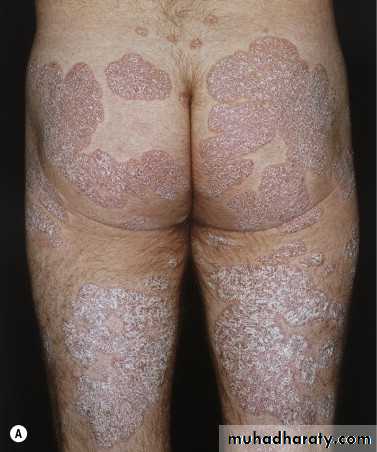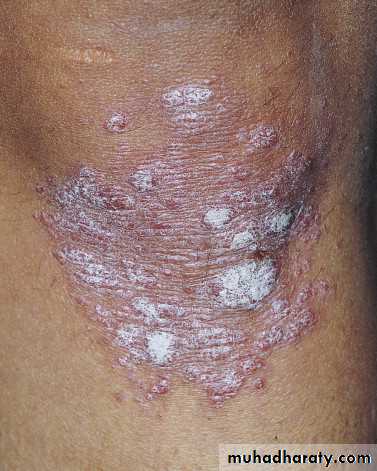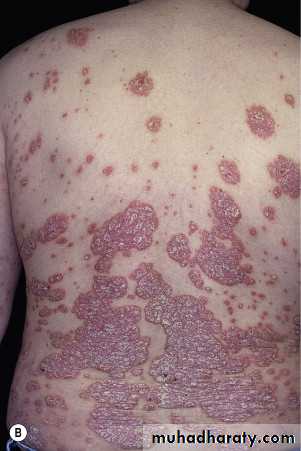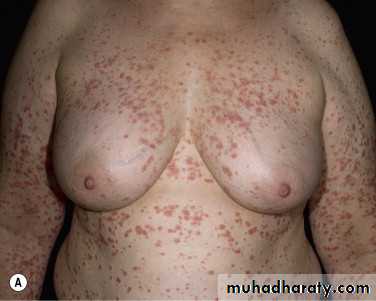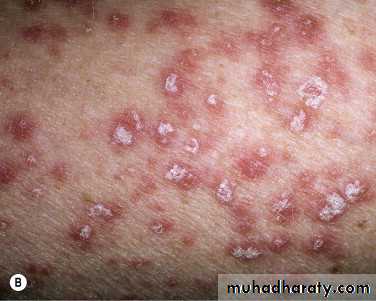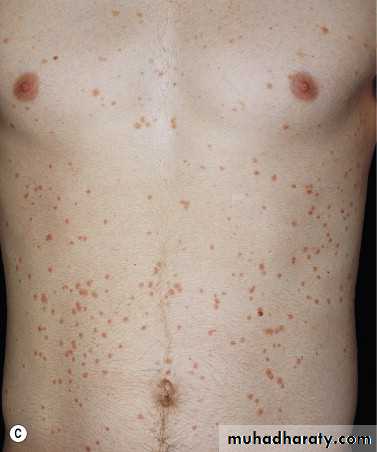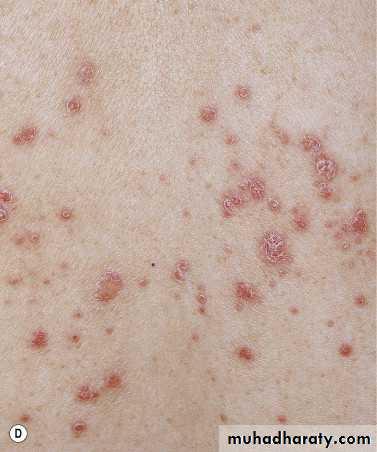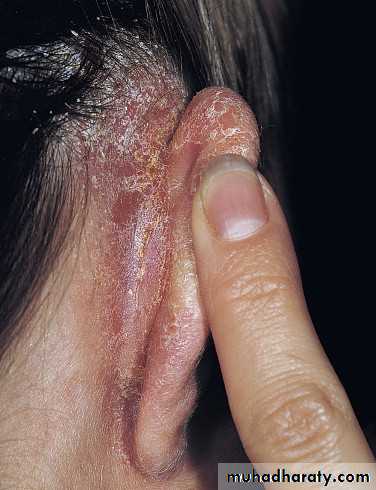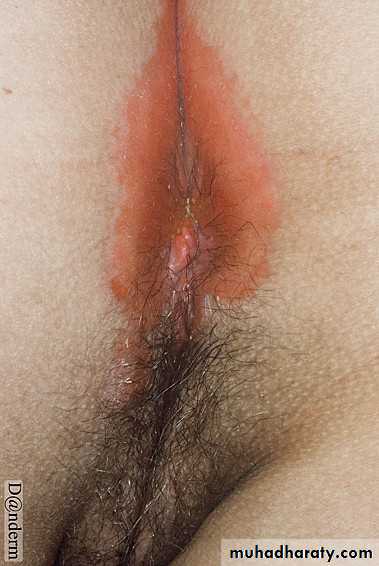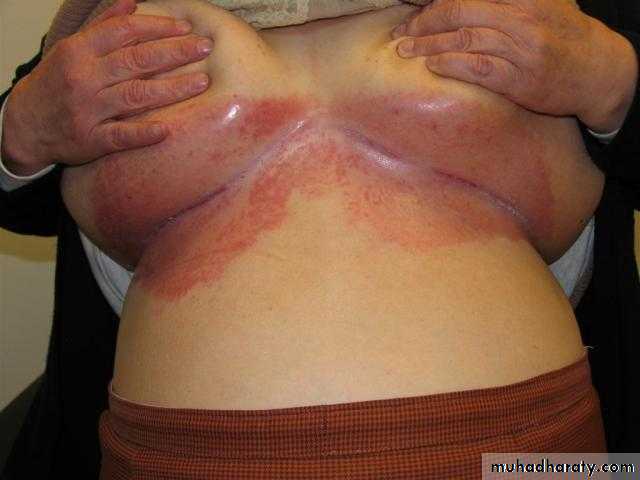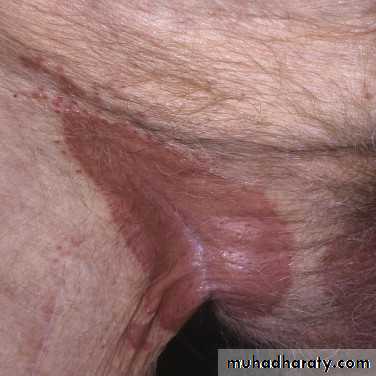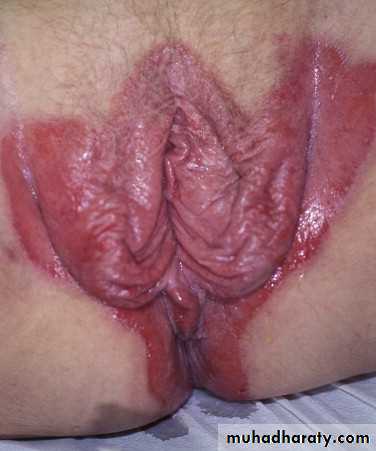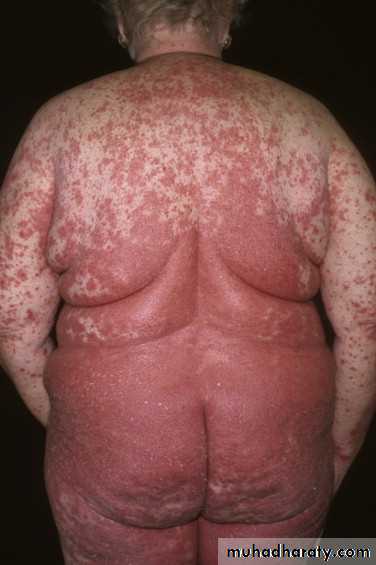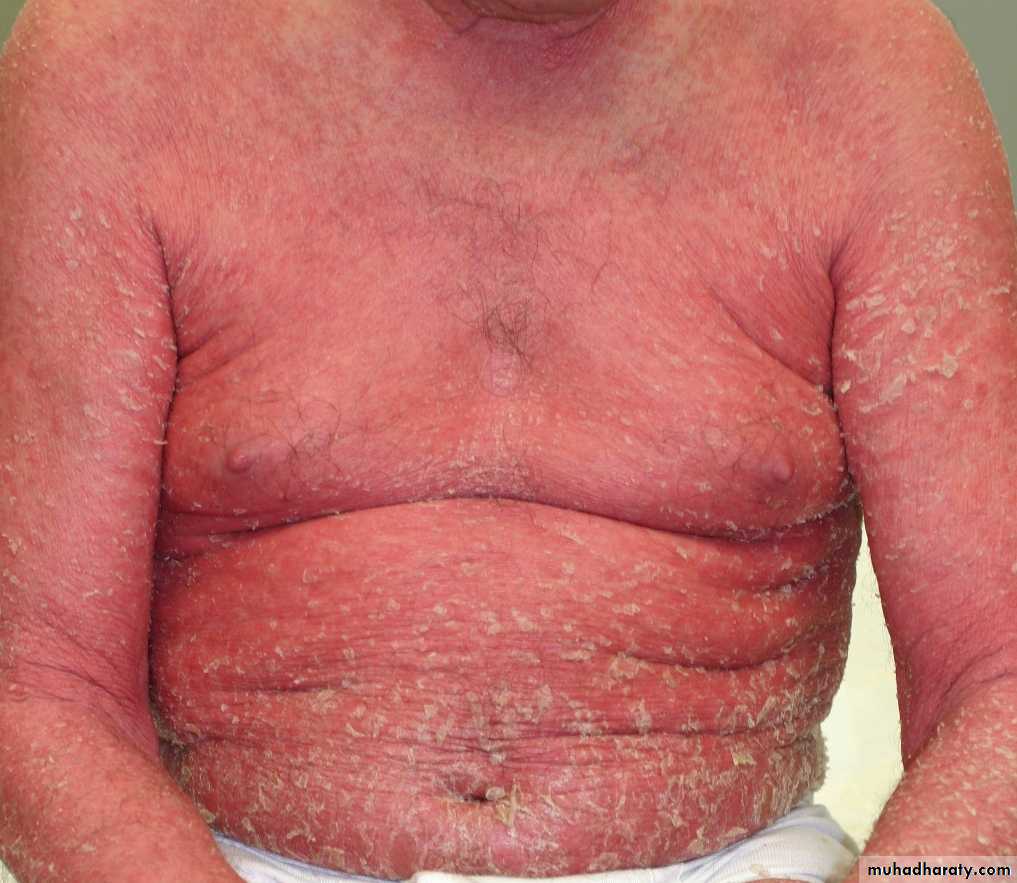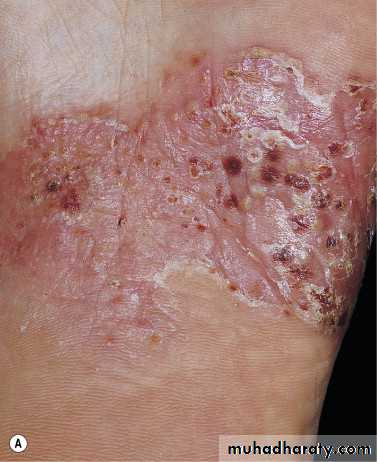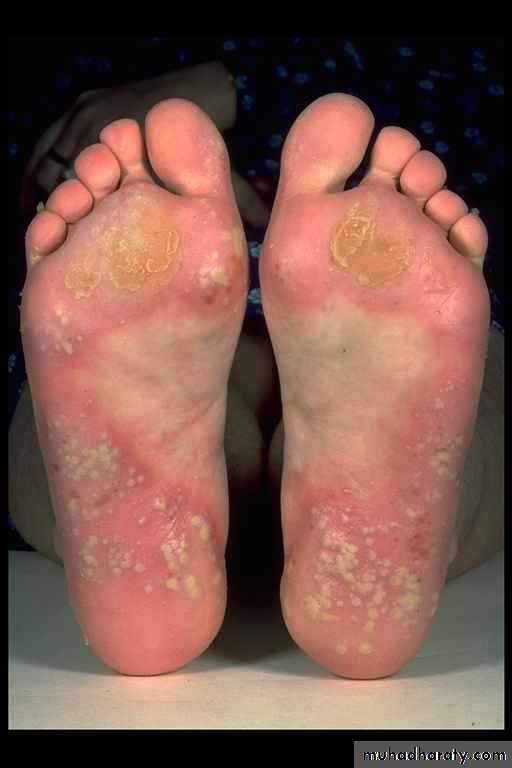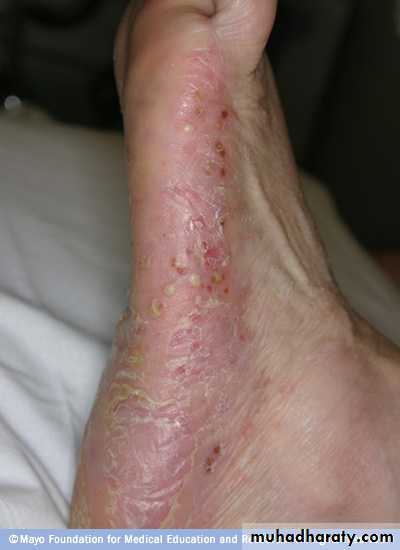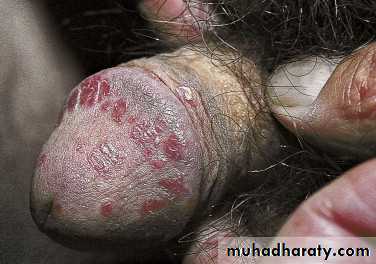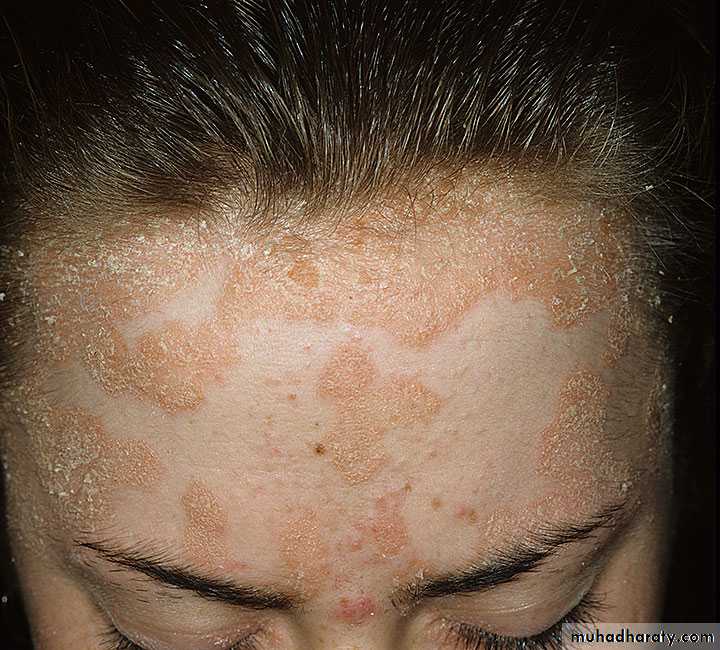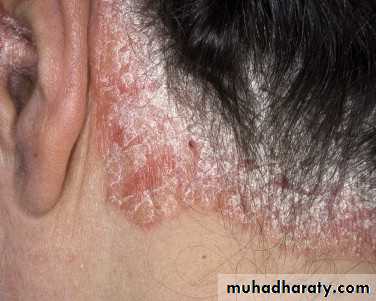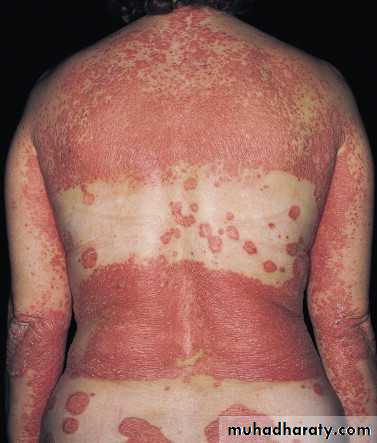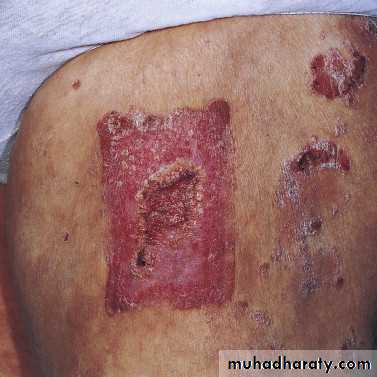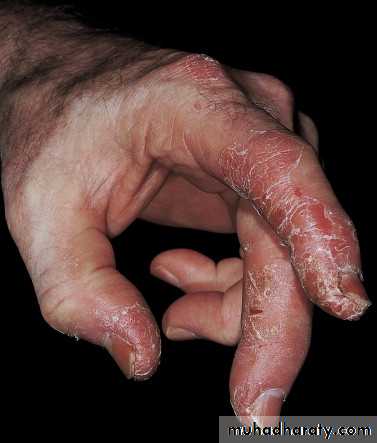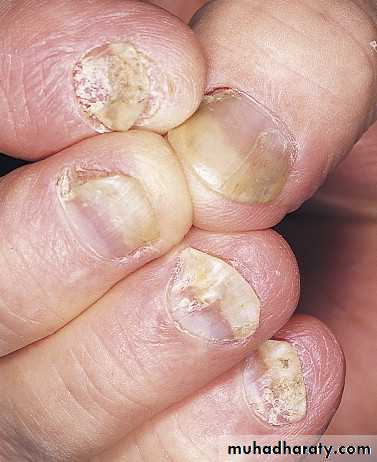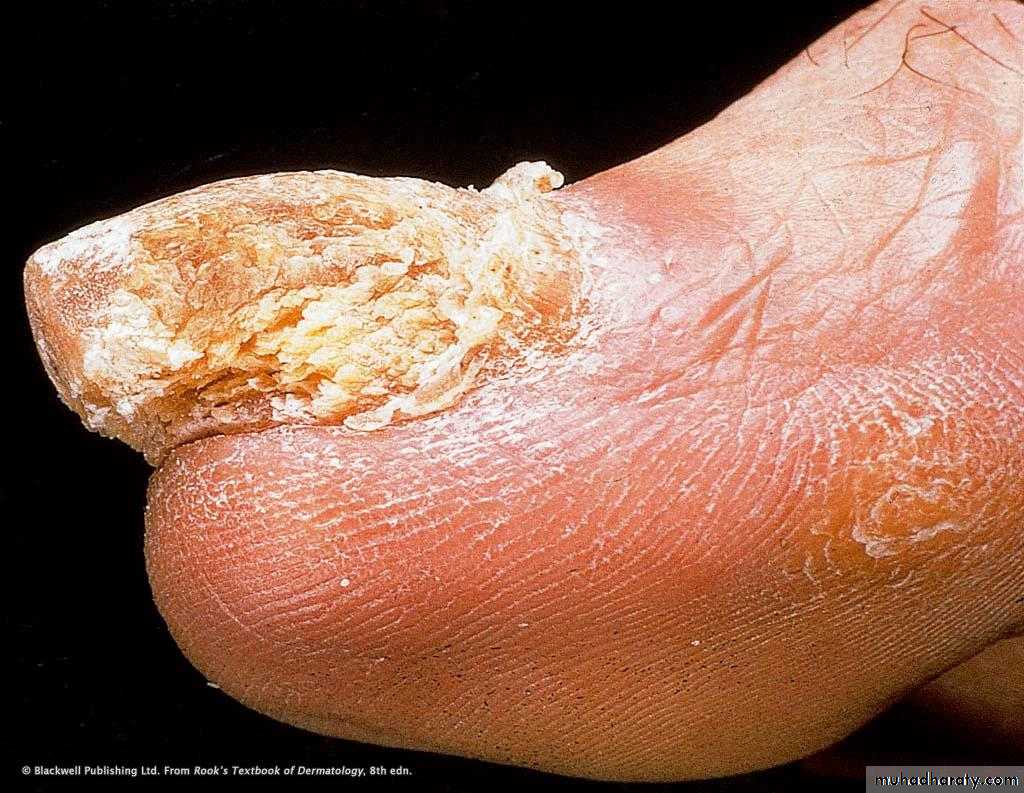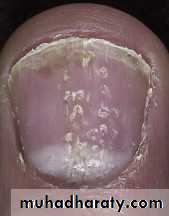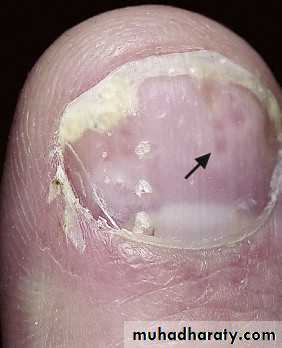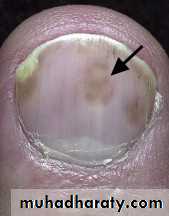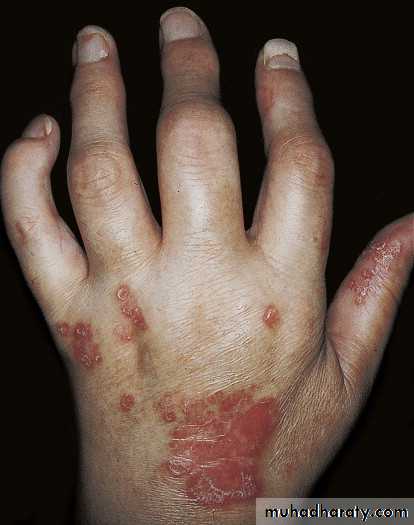Psoriasis
Omar Y. AbdullahIntroduction
Psoriasis occurs in 1% to 3% of the population.The disease is transmitted genetically (most likely a dominant
mode).
The disease is lifelong and characterized by chronic, recurrent
exacerbations and remissions that are emotionally and
physically debilitating.
There may be many millions of people with the potential to
develop psoriasis but certain environmental factor(s) is (are)
needed to precipitate the disease (stress, drugs, infection).
Environmental factors also may modify the course and
severity of disease.
Extent and severity of the disease vary widely from patient to
another as well as itching.
Pathogenesis
Psoriasis is a genetic, immune-mediated skin and/or joint inflammatory disease in which intralesional inflammation stimulates basal keratinocytes to hyperproliferate.
Environmental factors play an important role in the pathogenesis of psoriasis, including drugs, skin trauma (Koebner phenomenon), infection, and stress.
Drugs that precipitate or exacerbate psoriasis
LithiumAntimalarial agents
Beta blocking agents
Systemic steroids
Interferon
Comorbidities associated with psoriasis
Patients with psoriasis are at a higher risk for the following comorbidities than is the general population:• Crohn’s dis. and UC (3.8 to 7.5 times); families with MS.
• Cardiovascular disease
• Metabolic syndrome???
• Lymphoma (1.5 to 3 fold); non-melanoma skin cancer (250 PUVAs – 14 fold SCC)
• Depression/suicide
• Psychological/sexual dysfunction
• Smoking
• Alcohol
• Obesity
• Quality of life
Clinical presentations
A. Variations in the morphology of psoriasis:
Chronic plaque psoriasis
Guttate psoriasis
Pustular psoriasis
Erythrodermic psoriasis
Light-sensitive psoriasis
HIV-induced psoriasis
Keratoderma blennorrhagicum (Reiter syndrome)
B. Variations in the location of psoriasis:
Scalp psoriasisPsoriasis of the palms and soles
Pustular psoriasis of the palms and soles
Pustular psoriasis of the digits
Psoriasis inversus
Psoriasis of the penis and Reiter syndrome
Nail psoriasis
Psoriatic arthritis
Chronic plaque psoriasis
Chronic, noninflammatory, well-defined plaques.
The plaques are irregular, round to oval.Predilection for extensor surfaces such as the elbows and knees but any site can be affected.
Silvery scale.
Tend to be symmetrically distributed.
Plaques enlarge and then tend to remain stable for months or years.
A temporary brown, white, or red macule remains when the plaque subsides.
Auspitz sign!!!
Guttate psoriasis (acute eruptive psoriasis)
More than 30% of psoriatic patients have their first episode before age 20An episode of guttate psoriasis might be the first indication of the patient’s propensity for the disease. Streptococcal pharyngitis or a viral upper respiratory tract infection may precede the eruption by 1 or 2 weeks.
Scaling papules suddenly appear on the trunk and extremities, excluding palms and soles. The scalp and face may also be involved.
Number varies, and their size may be that of a pinpoint up to 1 cm.
It may resolve spontaneously and it responds more readily to treatment than does chronic plaque psoriasis.
Dx?
Psoriasis inversus (psoriasis of the flexural or intertriginous areas)
The gluteal fold, axillae, groin, submammary folds, retroauricular fold, and the glans of the uncircumcised penis may be affected.The deep red, smooth, glistening plaques may extend to and stop at the junction of the skin folds, as with intertrigo or Candida infections. The surface is moist and contains macerated white debris. Cracking and fissures are common at the base of the crease.
Infection, friction, and heat may induce flexural psoriasis, a Koebner phenomenon.
Infants and young children may develop flexural psoriasis of the groin that extends onto the diaper area.
Erythrodermic psoriasis
Generalized erythrodermic psoriasis is a severe, unstable, highly labile disease.It may appear as the initial manifestation of psoriasis but usually occurs in patients with previous chronic disease.
Precipitating factors include the administration of systemic corticosteroids; the excessive use of topical steroids; use of tar and anthralin on acutely inflamed plaques; abrupt discontinuation of systemic therapy; phototherapy complications; severe emotional stress; infection.
Treatment includes bed rest, initial avoidance of all UV light, wet compresses, liberal use of emollients, increased protein and fluid intake, antihistamines for pruritus, avoidance of potent topical steroids, and, in severe cases, hospitalization.
Methotrexate, cyclosporine, or acitretin is used if rapid control is not obtained with topical therapy.
Pustular psoriasis of the palms and soles
Deep pustules first appear on the middle portion of the palms and insteps of the soles; they may remain localized or spread.The pustules do not rupture but turn dark brown and scaly as they reach the surface.
The surrounding skin becomes pink, smooth, and tender. A thick crust may later cover the affected area.
The course is chronic, lasting for years while the patient endures periods of partial remission followed by exacerbations so painful that mobility is affected.
There is a considerably higher prevalence of smoking in these patients.
Rx: Acitretin, methotrexate, PUVA, narrow-band UVB, and intermittent courses of topical steroids under plastic occlusions.
Psoriasis of the nails
Onycholysis?Subungual hyperkeratosis?
Pitting?
Oil spot sign?
Nail dystrophy?
Psoriatic arthritis
Psoriatic arthritis (PsA) is a chronic inflammatory arthropathy of the peripheral joints, spine, and entheses.It is associated with psoriasis in which rheumatoid factor and anti-cyclic citrullinated peptide (anti-CCP) measurements are usually negative.
It may precede (15%), accompany, or, more often, follow the skin manifestations.
Unlike in rheumatoid arthritis, the distal interphalangeal joints are regularly involved.
The presence of inflammatory arthritis in patients with psoriasis varies between 5% and 42%.
The prevalence of psoriatic arthritis is higher among patients with more severe cutaneous disease.
Nail involvement occurs in more than 80% of patients with psoriatic arthritis, compared with 30% of patients with uncomplicated psoriasis.
Patients with psoriatic arthritis who become pregnant improve or even remit in 80% of cases.
Despite active treatment and a reduction in joint inflammation and the rate of damage, psoriatic arthritis may be a progressively deforming arthritis.
Moll and Wright 1973 classification of psoriatic arthritis
• Oligoarticular assymmetric arthritis: small joints of fingers and toes.• Polyarticular symmetric arthritis (RA-like): small joints of hands and feet, wrists, ankles, knees and elbows.
• Distal interphalangeal joint predominant: Mild, chronic, not disabling, and associated with nail disease. Involves hands and feet. This is the most characteristic presentation of arthritis with psoriasis.
• Destructive polyarthritis (arthiritis mutilans): small joints of hands and feet (gross deformity and subluxation).
• Ankylosing spodylitis and sacroiliitis: May occur alone or in association with peripheral joint disease (Males+sacroiliitis; HLA-B27+spondylitis).
• To meet the Moll and Wright classification criteria , a patient with psoriasis and inflammatory arthritis who is seronegative for rheumatoid arthritis (RA) must present with one of the above five clinical subtypes.

